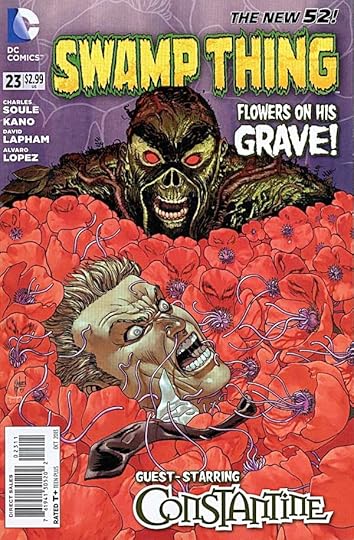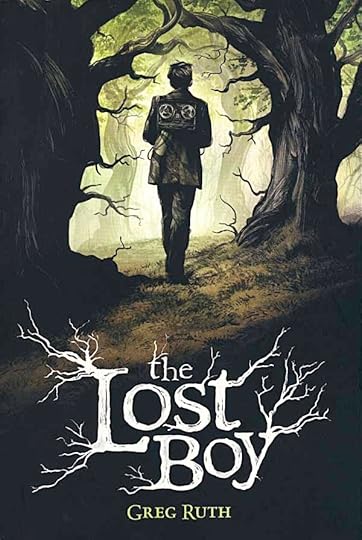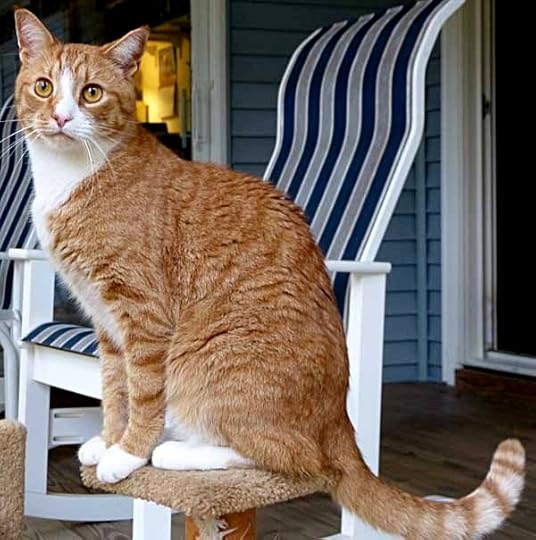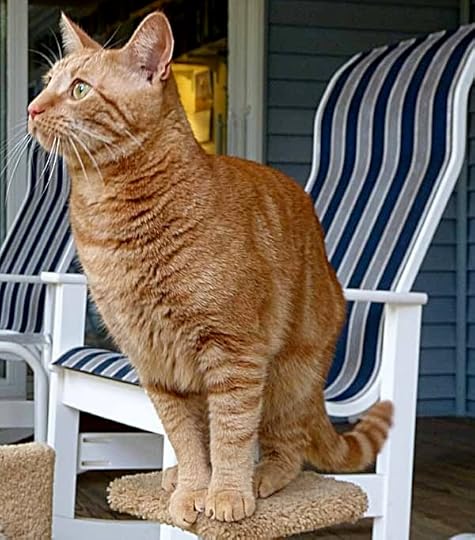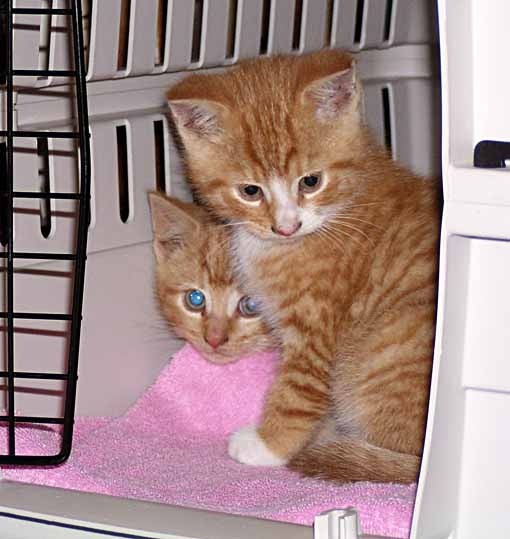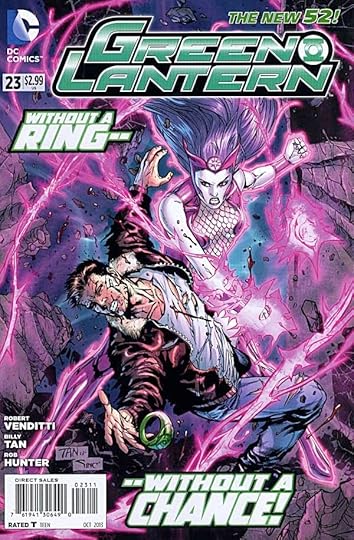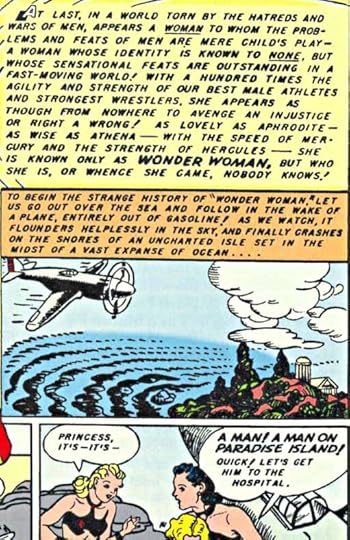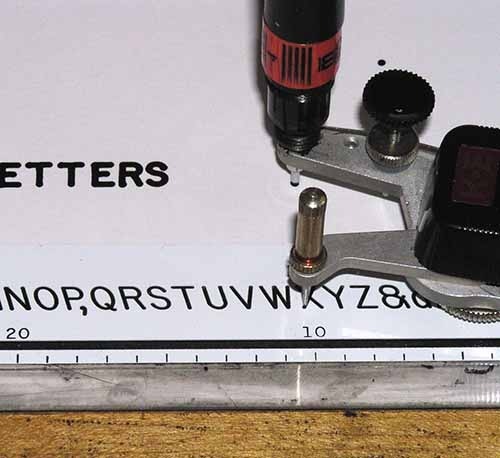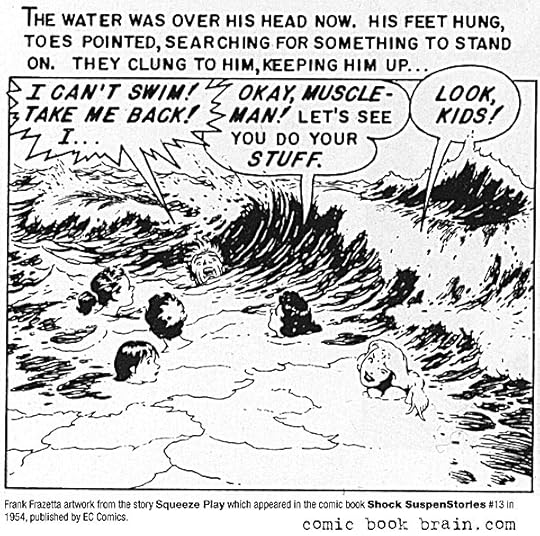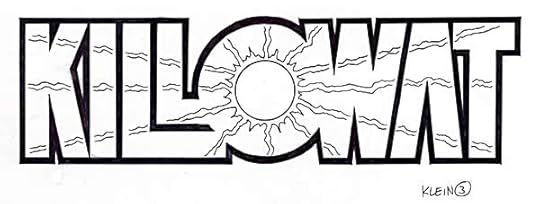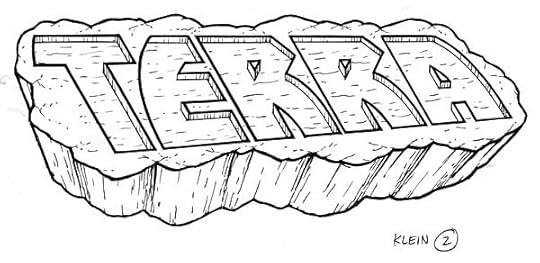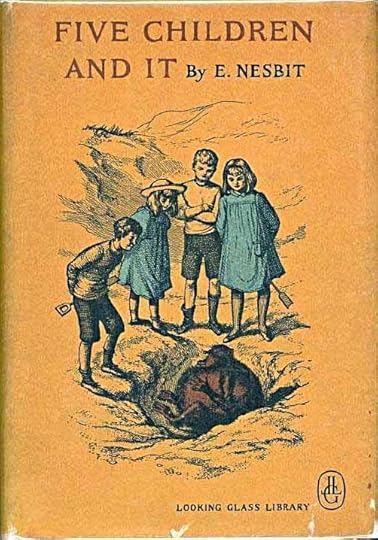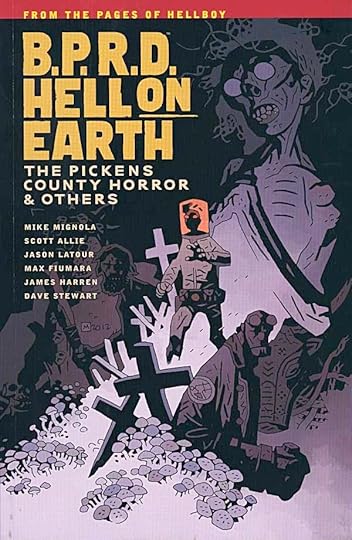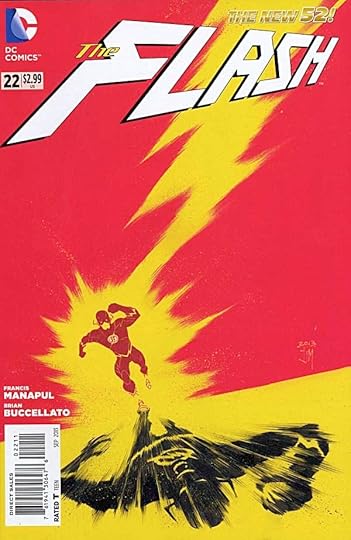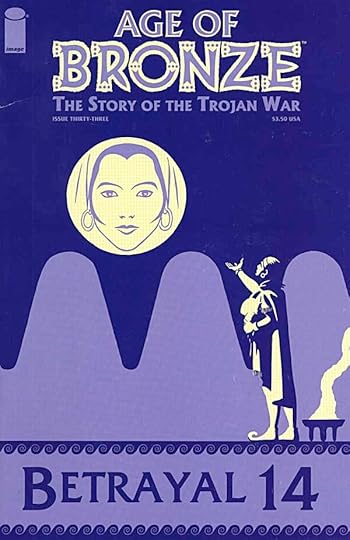Todd Klein's Blog, page 265
October 16, 2013
And Then I Read: SWAMP THING 23
Image © DC Comics, Inc.
This issue was more miss than hit for me. While I like the way writer Charles Soule is handling Swamp Thing himself, and the new characters he’s introduced work fine, I dislike his Constantine rather strongly. Admittedly, in this issue Constantine has been taken over by a sort of demonic whiskey planted by the true villain, Seeder, but the intelligence and resourcefulness of the Constantine I remember is completely absent. Here he’s just a mindless monster. I’d like to think he could be used better. There are a few nice moments at the end of this issue, but in general I didn’t care for the art that much either. The townsfolk and Constantine seem mere caricatures of even what they were in the previous issue. Can’t recommend this one.
October 15, 2013
And Then I Read: THE LOST BOY by Greg Ruth
Image © Greg Ruth.
I’m very impressed with this graphic novel written and drawn by Greg Ruth. I don’t think I’ve seen his work before, though he’s been around for over a decade. Both the writing and art are excellent. The writing is layered, with realistic kids in both the present and the past atop a menacing structure of dark magic and odd creatures. The art is black and white with masterful gray tones, often utilizing a dry brush look that is perfect for the story. The characters come to life with the subtle nuances of real expressions and action placed in settings full of mundane reality or atmospheric menace and high fantasy when needed.
Nate, a teenage boy, and his family are moving into a new home in a small country town. Nate does not seem happy about this, though when he looks out the window of his new bedroom to see a large, impressive treehouse in the yard, he perks up. Another find is more important: a squeaky floorboard is lifted to reveal a hidden tape recorder and tapes. Shortly into the book Nate begins to play the tapes, but we the reader see what he hears as a new narrative by another boy named Walter from many years in the past.
Walter’s tapes are a sort of diary and report on many strange happenings and fantastic beings he’s been seeing around town, and in nearby Crow’s Woods. Creatures like a talking squirrel, a living toy doll and a cricket riding a dog and wielding bow and arrows are one thing, other creatures are much more powerful and menacing. Walter seems to have few friends, though he does have one ally in town, a shop owner named Haloran who not only believes Walter’s stories, but seems to know a lot about the deep magic and hidden evil below the surface of the quaint town.
Back in the present, Nate is befriended by Tabitha, a girl his age who’s been investigating the magic and the disappearance of Walter years ago. Nate and Tabitha are soon drawn into deep danger in Crow’s Woods in an exciting quest to find the lost boy.
Highly recommended.
October 14, 2013
Tigger and Leo are Four
Tigger, above, Leo below.
Our orange brother cats were born four years ago today. They’re adopted, and it’s not usual to know the exact birthdate in that case, but they were born to a stray cat in the barn of a friend of Ellen, so that’s how we know.
It seems only yesterday that we brought them home, but they WERE a lot smaller then! And very cute and funny nearly all the time. Now they’re more sedentary adults. They do run around once in a while, and act crazy, but not as often. And when they do, it’s hard to get pictures. As soon as the camera comes out, they stop! I did manage to get a short video clip of them playing with a leaf on our screened porch today, though they play a lot more actively than this usually.
TiggerLeoAge4 from Todd Klein on Vimeo.
We love our kitties, sorry for being self indulgent, but there we are.
October 13, 2013
And Then I Read: GREEN LANTERN 23
Image © DC Comics, Inc.
Hal is trying to run things on Oa in the absence of the new Guardians, who are off at the edge of known space. He finds the new recruits the power rings have brought in to be less than ideal, but another problem takes precedence: the escape of a female prisoner, Prixiam, who has killed a young Green Lantern on her way out. Hal tracks Prixiam and attempts to bring her in, only to find she has the ring and powers of a Star Sapphire. And Prixiam’s case seems more complex than he expected.
Pretty good story by Robert Venditti, nice art by Billy Tan and Rob Hunter. Recommended.
October 11, 2013
Leroy Lettering by Jim and Margaret Wroten
Image © DC Comics, Inc.
I’m often asked about the style of lettering used in the Golden Age Wonder Woman stories, the same style used in many of the EC horror comics of the 1950s. It has a mechanical look, but is actually pen and ink, made with the Leroy lettering system of scriber and templates manufactured by the Keuffel and Esser company, and created for comics almost exclusively by Jim Wroten and his wife Margaret. The Leroy system was intended for technical artists doing things like machine parts diagrams and architectural drawings. I got one years ago, before I started working in comics. Here’s what mine looks like:
The scriber holds a technical inking pen on one arm. A second arm has a pin that follows letters on the template. A third arm has a pin that slides along the bottom groove to help keep the letters aligned horizontally. Templates come in different sizes, and you can make vertical letters or slanted letters, with the angle changed by adjusting the pin arm of the scriber. Thickness of the letters can be changed by using different size pen points. When lettering you would place your comics art on a drawing board, taped in place and made level using a t-square. Then you would place the Leroy template against the top edge of the t-square. While holding the t-square with one hand or arm to keep it from sliding vertically, you would form one letter at a time with the scriber, pen and template, sliding the template horizontally to get the correct letter in the correct spot, and of course shifting the scriber’s pin to the right letter on the template.
It all sounds more complicated than it works in practice, but in fact it’s a monstrously difficult and time-consuming way to letter a comic. I tried lettering a 6-page SUPREME story with it once, and it took me about three hours per page, more than five times my usual speed for hand-lettering. As with all things, I’m sure you’d get faster with practice, but I vowed to never do it again, and made a computer font from my Leroy letters for any future need. But the Wrotens must have become quite facile with it, as they lettered thousands of comics pages that way.
It’s interesting to see that on the early Wonder Woman effort above, they only had one size template and pen, and for larger words had to use hand-lettering. All the lettering is slanted to the right, the style used for all the WONDER WOMAN stories I looked at. Some words are emphasized by underlining, something you almost never see in comics. Perhaps Wroten was a friend of Wonder Woman artist H.G. Peter and got started in comics working with him, I don’t know.
Image © EC Comics, Inc.
By the time of their work in EC Comics, the Wrotens had a variety of Leroy templates to use for different size lettering. They used vertical letters for regular text and a larger size slanted to the right with a thicker pen point for emphasized words. I believe the Wrotens did only the actual lettering, leaving the balloon and caption borders for the artists of the stories. This accounts for the wide variety of balloon shapes and styles at EC in particular. Some EC artists, like Wally Wood, hated the mechanical look of the Leroy lettering, and Wood was a fine letterer himself, so when he had time he lettered his own stories, or tried to get them lettered by pros like Ben Oda.
After the demise of the EC horror line, comics work for the Wrotens seems to have dried up. At least I haven’t seen any examples of their Leroy lettering at other publishers from after the EC work. Not much is known to me about the Wrotens, but I imagine they found other jobs, perhaps in areas where Leroy lettering was still being used like architectural drawings.
Pulled From My Files #11
Images © DC Comics.
Here’s a logo sketch in markers that is something of a mystery to me. It’s number 3, but I don’t have the first two, nor do I have a finished logo, though I was paid for one in 1992. It’s for a Teen Titans character who first appeared in Team Titans in that year I believe, but I don’t know if or where the logo might have been used. It’s not a great logo, but I do like the way I handled the second L.
This is again the only sketch I have for this logo done in markers, and I don’t have the finished logo. It was also paid for in 1992, and is, of course, another Teen Titans character, an infamous one. I’m pretty sure this is the design chosen for the final logo, but I don’t know where it was used. I think it’s a good idea, though I’m not sure how well it worked in color.
October 10, 2013
Rereading THE FIVE CHILDREN AND IT by E. Nesbit
In the 19th century a new type of children’s novel was born, one where ordinary children encountered magical beings or objects of magical power. “The Water Babies” by Charles Kingsley of 1863 is the earliest of these I know about, but the children in the story are romanticized and very much as the Victorian era saw children rather than as they really are. Lewis Carroll’s “Alice in Wonderland” of 1865 is better, though Carroll’s Alice was a rather odd child, cold and unemotional and perhaps not very realistic either. George MacDonald’s “At The Back Of The North Wind” of 1871 is the next likely candidate, followed by his “The Princess and the Goblin,” but MacDonald’s children were also romanticized.
Edith Nesbit broke new ground with “The Story of the Treasure Seekers” of 1899. Her Bastable family was very realistic. While generally good kids, they got into mischief, had quarrels and temper tantrums, were sneaky around adults, and were not above small lies to get what they wanted. The Bastable books are fine reading, but they are ordinary adventures in an ordinary world. With “The Five Children and It,” Nesbit brought her talent for writing realistic children to the fantasy genre, and it has not looked back since.
Five children: Robert, Anthea, Jane, Cyril, and the family baby, The Lamb, are sent to spend the summer at a house in the country next to a sand pit, which seems to be an open sand mine, no longer in use. They are being cared for by servants — their parents are absent — a classic set-up for adventures. The servants allow them to go off all day to play as long as they bring the baby with them and care for him, which they are willing to do, though he can be tiresome. The sand pit is a magnet, and while digging there they uncover a very odd creature that seems sort of a cross between a fat monkey and a shell-less snail. They are astonished when it speaks to them, and they learn it is a Psammead, or sand fairy, buried in this sand for many centuries and only now awakened. The children learn it can grant wishes, and the Psammead, a very grumpy creature, grudgingly grants them one wish a day, setting up all the adventures in the book. The effects of the wishes will only last until sunset, which as it turns out is a good thing!
When you were a child, what would you have wished for? These children never seem to get any pleasure from their wishes, every one goes wrong somehow, perhaps due to the spite of the Psammead, or simply their own bad judgment. Even a wish for wings that will allow them to fly goes wrong when they decide to steal some food and fly up to the roof of a church to have a picnic, then foolishly fall asleep until the wings are gone and they’re stuck there. Wishing for piles of gold coins doesn’t get them anything they want either, and instead throws them into all kinds of trouble.
There is definitely a moral lesson to be found in each of the adventures, but plenty of exciting and funny moments too, and the characters are appealing, flaws and all. Nesbit wrote three books about these children, each with a different sort of magic in it, and all are excellent. I’ll be rereading the other two soon. Incidentally, though that’s my hardcover copy above, I read this as a free iBook, and found this version a much better conversion than Nesbit’s “The Magic Castle,” reviewed here a while back. Only the illustrations fail, the images are so pixilated as to be unreadable, but the text is fine.
Highly recommended.
October 9, 2013
And Then I Read: B.P.R.D. Volume 5
Image © Mike Mignola.
This volume of B.P.R.D. collects some side stories and follows the larger continuity only slightly. Doesn’t matter, they’re good stories full of choice weirdness and scary moments. Like a good horror movie, the Mignola world rarely fails to bring us places we don’t really want to go, and being a protagonist in a Mignola story is usually not a good thing.
Agents Vaughn and Peters investigate the “Pickens County Horror,” a story of death, frogs, ghosts, deadly mist and vampires. You’d have to be pretty crazy to go near the house in this story…
“The Transformation of J.H. O’Donnell” explains why you wouldn’t want to be a field consultant to the B.P.R.D. no matter how fascinating the subject, how rare the ancient books, and how well-protected you felt in the company of Hellboy himself.
“The Abyss of Time” takes agent Howards on a trip deep into the past when he touches an ancient weapon. He soon finds himself in a battle against evil perhaps even more hopeless than the one going on in the present.
Recommended.
October 8, 2013
And Then I Read: THE FLASH 22
Image © DC Comics, Inc.
THE FLASH has been on a great run in the hands of Francis Manapul and Brian Buccellato, and it continues here. Barry Allen, despite all his power, has failed to stop the deaths of most of the people who were trapped inside the Speed Force. Now only Iris West remains, and he is determined to save her. Barry’s every move has been undermined by a shadowy figure finally fully revealed here, and then the battle of two equally powerful men is on, at super-speed, and who knows where that will lead. Dr. Elias, another Flash nemesis, is already being drawn into the chaos.
Recommended.
October 7, 2013
And Then I Read: AGE OF BRONZE 33
Image © Eric Shanower.
AGE OF BRONZE is the story of the Trojan War expanded to include all the additions to and variations of the original epic poem by Homer by later writers like Shakespeare and Chaucer. Epic is the word. It’s very complex, with a huge cast of characters. The book comes out infrequently. I suspect Eric does not make much money from it, and needs to take other work to support this project, clearly a labor of love. With all that said, as soon as I open a new issue I’m drawn right back into the characters, emotions and drama of the story. It’s that good.
The focus is now on Cressida, a beautiful young Trojan woman. Her father, Kolchas, has defected to the Achaean army, the ones beseiging the city of Troy. Cressida finally decides to join him, and finds her new life in an enemy camp to be quite horrible. Worse, her true love, the Trojan prince Troilus is waiting each night on the wall of the city where Cressida said she would soon return to him. Clearly the young girl’s plans were more wish-fulfillment than practical. Will she have to give up her ideals and her true love to survive among the Achaeans? And how will Troilus react when he returns to fight them?
We’re way into the story, but this issue is good enough to be enjoyed on its own, with a little help from “Our Story So Far” on the inside cover. Highly recommended.
Todd Klein's Blog
- Todd Klein's profile
- 28 followers


